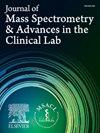采用LC-MS/MS鉴别处方安非他明患者的尿甲基苯丙胺与药物杂质
IF 3.4
4区 医学
Q2 MEDICAL LABORATORY TECHNOLOGY
Journal of Mass Spectrometry and Advances in the Clinical Lab
Pub Date : 2025-07-11
DOI:10.1016/j.jmsacl.2025.07.001
引用次数: 0
摘要
服用处方安非他明(AMPH)的患者尿液中不应检测到甲基苯丙胺(METH);可检测到的冰毒通常表明非法使用。然而,我们已经确定患者的结果提示甲基苯丙胺作为处方AMPH的杂质。目的:从符合AMPH处方的患者训练集中得出甲基苯丙胺:AMPH比率截止值,以区分甲基苯丙胺作为杂质与非法使用。方法采用液相色谱-串联质谱法(LC-MS/MS)对布里格姆妇女医院(BWH)和卢克索科学公司(Luxor Scientific)的AMPH和meth阳性病例进行回顾性分析。结果与临床、用药史及遵医嘱相关。结果Adderall训练集的METH:AMPH比值中位数±四分位数范围(IQR)分别为0.43±0.31%和0.05±0.040%,其中BWH和Luxor训练集的最大值分别为1.125%和0.125%。Luxor d-AMPH训练集的中位数±IQR METH:AMPH比值为0.039±0.028%,最大值为0.09%;与阿得拉训练集没有统计学差异。对BWH测试集的评估,其中METH <;AMPH (n = 22)显示甲基安非他明可能是由于杂质(n = 10),远距离甲基安非他明误用(n = 11)或需要进一步分析(n = 1)。在商用AMPH校准器和Adderall XR中也采用LC-MS/MS检测甲基苯丙胺。甲基安非他明可能代表AMPH制剂中的杂质。鼓励实验室确定一个甲基安非他明:AMPH比率,低于该比率的杂质可能是甲基安非他明的原因,和/或将甲基安非他明的阳性截止值提高到50或100纳克/毫升,以减少非法使用甲基安非他明的潜在错误指控。本文章由计算机程序翻译,如有差异,请以英文原文为准。
Urine methamphetamine-to-amphetamine ratio by LC-MS/MS to differentiate methamphetamine use from pharmaceutical impurity in patients prescribed amphetamine
Introduction
Patients compliant with prescribed amphetamine (AMPH) should not have detectable methamphetamine (METH) in their urine; detectable METH typically indicates illicit use. However, we have identified patients with results suggestive of METH as an impurity in prescribed AMPH.
Objectives
Derive a METH:AMPH ratio cut-off from a training set of patients compliant with AMPH prescriptions to differentiate METH as an impurity from illicit use.
Methods
Retrospective review of AMPH and METH-positive cases by liquid chromatography-tandem mass spectrometry (LC-MS/MS) at Brigham and Women’s Hospital (BWH) and Luxor Scientific. Correlated results with clinical and medication history and compliance with prescribed medications.
Results
The median ± interquartile range (IQR) METH:AMPH ratio for the Adderall training sets was 0.43 ± 0.31 % and 0.05 ± 0.040 %, with a maximum ratio of 1.125 % and 0.125 % at BWH and Luxor, respectively. The median ± IQR METH:AMPH ratio for the Luxor d-AMPH training set was 0.039 ± 0.028 %, with a maximum ratio of 0.09 %; not statistically different from the Adderall training set. Assessment of the BWH test set where METH < AMPH (n = 22) revealed that METH was likely due to an impurity (n = 10), distant METH mis/use (n = 11), or requiring further analysis (n = 1). METH was also detected by LC-MS/MS in a commercial AMPH calibrator and in Adderall XR.
Discussion
METH may represent an impurity in the AMPH formulation. Laboratories are encouraged to define a METH:AMPH ratio below which an impurity is the likely explanation for METH and/or to increase the METH positivity cut-off to 50 or 100 ng/mL to reduce potential false-accusations of illicit METH use.
求助全文
通过发布文献求助,成功后即可免费获取论文全文。
去求助
来源期刊

Journal of Mass Spectrometry and Advances in the Clinical Lab
Health Professions-Medical Laboratory Technology
CiteScore
4.30
自引率
18.20%
发文量
41
审稿时长
81 days
 求助内容:
求助内容: 应助结果提醒方式:
应助结果提醒方式:


